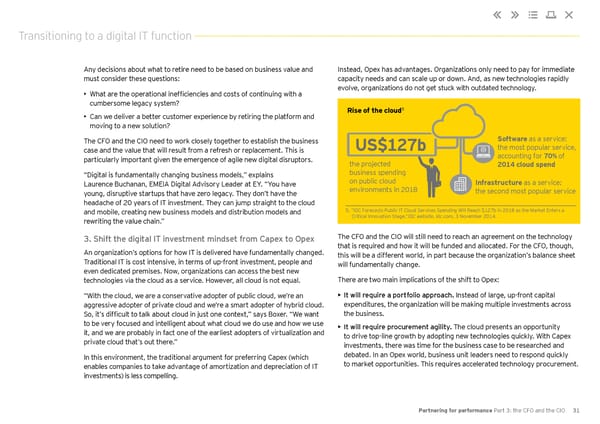Transitioning to a digital IT function Any decisions about what to retire need to be based on business value and Instead, Opex has advantages. Organizations only need to pay for immediate must consider these questions: capacity needs and can scale up or down. And, as new technologies rapidly • What are the operational inefficiencies and costs of continuing with a evolve, organizations do not get stuck with outdated technology. cumbersome legacy system? of CFOs from technology firms Rise of the cloud5 • Can we deliver a better customer experience by retiring the platform and moving to a new solution? say they make a “very significant” contribution to the information Software as a service: management strategy, compared The CFO and the CIO need to work closely together to establish the business US$127b the most popular service, with a sector average of 16%. case and the value that will result from a refresh or replacement. This is accounting for 70% of particularly important given the emergence of agile new digital disruptors. the projected 2014 cloud spend “Digital is fundamentally changing business models,” explains business spending Laurence Buchanan, EMEIA Digital Advisory Leader at EY. “You have on public cloud Infrastructure as a service: young, disruptive startups that have zero legacy. They don’t have the environments in 2018 the second most popular service headache of 20 years of IT investment. They can jump straight to the cloud and mobile, creating new business models and distribution models and 5. “IDC Forecasts Public IT Cloud Services Spending Will Reach $127b in 2018 as the Market Enters a rewriting the value chain.” Critical Innovation Stage,”IDC website, idc.com, 3 November 2014. 3. Shift the digital IT investment mindset from Capex to Opex The CFO and the CIO will still need to reach an agreement on the technology An organization’s options for how IT is delivered have fundamentally changed. that is required and how it will be funded and allocated. For the CFO, though, Traditional IT is cost intensive, in terms of up-front investment, people and this will be a different world, in part because the organization’s balance sheet even dedicated premises. Now, organizations can access the best new will fundamentally change. technologies via the cloud as a service. However, all cloud is not equal. There are two main implications of the shift to Opex: “With the cloud, we are a conservative adopter of public cloud, we’re an • It will require a portfolio approach. Instead of large, up-front capital aggressive adopter of private cloud and we’re a smart adopter of hybrid cloud. expenditures, the organization will be making multiple investments across So, it’s difficult to talk about cloud in just one context,” says Boxer. “We want the business. to be very focused and intelligent about what cloud we do use and how we use • It will require procurement agility. The cloud presents an opportunity it, and we are probably in fact one of the earliest adopters of virtualization and to drive top-line growth by adopting new technologies quickly. With Capex private cloud that’s out there.” investments, there was time for the business case to be researched and In this environment, the traditional argument for preferring Capex (which debated. In an Opex world, business unit leaders need to respond quickly enables companies to take advantage of amortization and depreciation of IT to market opportunities. This requires accelerated technology procurement. investments) is less compelling. Partnering for performance Part 3: the CFO and the CIO 31
 Partnering for Performance Part 3 Page 30 Page 32
Partnering for Performance Part 3 Page 30 Page 32